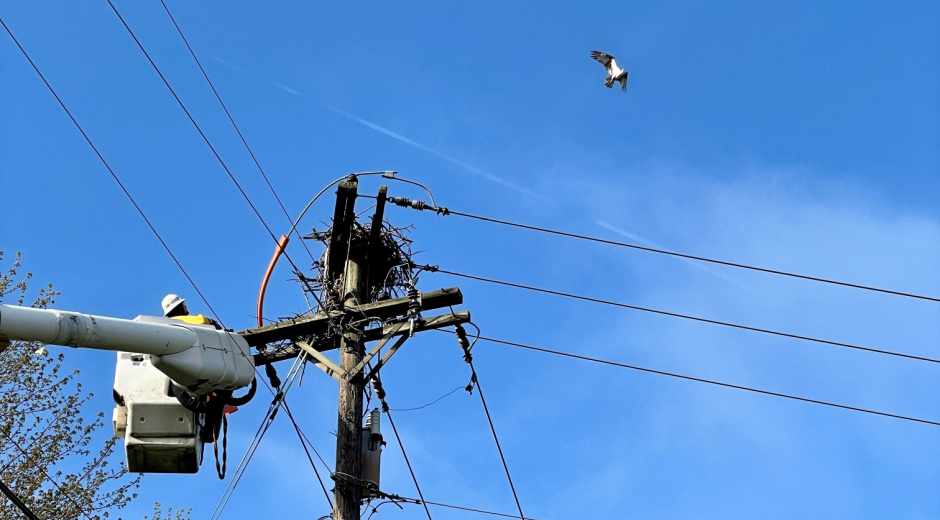Penn Power Utility Personnel Showcase Quick, Strategic Thinking Skills to Protect Active Osprey Nest Atop Utility Pole
In an industry where work plans are dependent upon weather conditions and other external factors, handling unforeseen challenges – in a seemingly effortless fashion – is nothing new to line workers at FirstEnergy’s electric companies.
A Penn Power line crew in western Pennsylvania recently put their quick and strategic thinking skills on display when they partnered with state and federal wildlife agencies to remove an osprey nest containing eggs that was situated on a utility pole. Disturbing or removing the nests can be a complicated task due to environmental regulations. In most cases, an active nest containing eggs cannot be disturbed. The original plan was to safely remove the nest from the pole, then install a nesting platform atop the pole to provide a safe location for the birds away from energized equipment.
Due to the proximity of the active nest near energized electrical equipment, Penn Power received approval from state and federal wildlife agencies to safely and proactively relocate the nest. However, when line workers began removing the nest, they immediately noticed that the size and weight of the osprey nest had put a lot of stress on the wooden crossarms and top of the pole.
WATCH TV CLIP: FirstEnergy works to leave osprey nest in place while protecting birds
“The goal of the project was to keep the osprey and her eggs safe around our power lines and equipment,” said Jeff Doran, operations manager at Penn Power. “With the birds’ best interest in mind, our crew determined the top of the pole was not in ideal condition to install a large nesting platform on top, and moving the nest into the platform ultimately posed a bigger threat to the birds.”
Unable to move the eggs to a nearby bird sanctuary because of permitting issues, Penn Power line workers came up with an alternate solution to protect the birds. They installed insulated bird guard coverings on the power lines and equipment near the nest to keep the birds safe until the eggs hatch and utility personnel can safely remove the nest and install the nesting platform in the fall.
An osprey can build a full-blown nest of branches, leaves, litter and dried grass in two days and start laying eggs. The nest creates a danger for the birds, their eggs and electric service reliability because the nest materials can conduct electricity when wet and catch the pole on fire. The fire can consume the nest, eggs or young osprey that cannot fly and disrupt electric service to the area.
Wildlife experts onsite said the osprey eggs should hatch by the end of May, if not sooner, and the osprey would eventually migrate south for the winter. At that point, Penn Power line workers will replace the pole with a new one capable of supporting a nesting platform for the birds in the future.
Protecting birds is nothing new to Penn Power. The company has made great strides enhancing its avian protection efforts, including the installation of more than a dozen nesting platforms atop utility poles, implementation of drones to complete bird nest inspections and deployment of a mobile app that allows utility personnel to report avian issues in real time, streamlining the process to protect nesting birds and enhance electric service reliability. These ongoing efforts continue to help reduce power outages caused by nesting birds.
MEDIA CONTACT: Lauren Siburkis, (330) 203-8850

